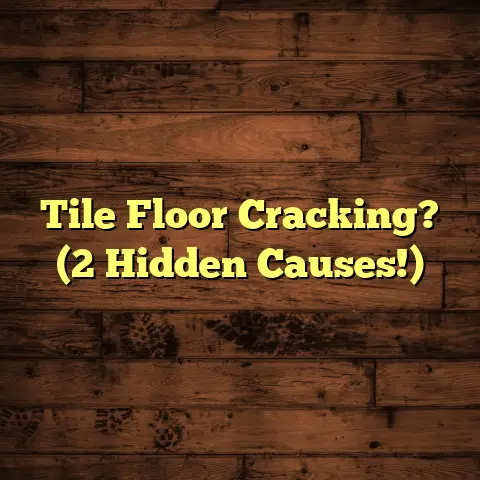Bathroom Tile Choices (2 Grout Goofs!)
That’s according to the National Kitchen and Bath Association. Can you believe it?
And guess what the biggest culprit is? Poor tile and grout choices!
I’m here to guide you through the maze of bathroom tile selection.
And, most importantly, help you dodge those frustrating grout goofs.
Let’s dive in and make sure your bathroom reno is a smashing success!
Section 1: The Importance of Tile Selection
Okay, so you’re dreaming of a spa-like bathroom, right?
It all starts with the tiles.
There are so many options: ceramic, porcelain, natural stone, glass… it’s enough to make your head spin!
Each type brings its own vibe and has different pros and cons.
Ceramic tiles are budget-friendly and come in a zillion styles.
But they’re not as tough as porcelain.
Porcelain tiles are super durable and water-resistant, perfect for a splash zone.
They can be a bit pricier, though.
Natural stone tiles (like marble or granite) scream luxury.
But they need extra TLC to keep them looking their best.
Glass tiles add a sleek, modern touch and reflect light beautifully.
But they can be slippery when wet, so choose wisely!
And don’t forget about the finish!
Glossy tiles are shiny and easy to clean.
But they can be slippery and show water spots like crazy.
Matte tiles offer better grip and hide smudges.
But they can be harder to clean if you get them dirty.
Textured tiles add visual interest and even more grip.
But they can trap dirt if you’re not careful.
I always tell my clients to think about how they actually use their bathroom.
Are you a low-maintenance person or a cleaning fanatic?
Do you have kids who will be splashing around?
These things matter!
Section 2: Understanding Grout
Now, let’s talk grout. It’s the unsung hero of any tile job!
Grout is that paste-like stuff that fills the gaps between your tiles.
It does more than just look pretty.
It keeps water from seeping behind the tiles and causing mold or structural damage.
Think of it as the bodyguard for your bathroom walls and floors.
There are three main types of grout: sanded, unsanded, and epoxy.
Sanded grout is used for tiles with wider grout lines (1/8 inch or more).
The sand adds strength and prevents cracking.
Unsanded grout is for tiles with narrow grout lines (less than 1/8 inch).
It’s smoother and won’t scratch delicate tiles like glass or polished stone.
Epoxy grout is the superhero of grouts. It’s super stain-resistant, waterproof, and durable.
It’s a great choice for high-traffic areas or places prone to spills.
But it’s also more expensive and trickier to install.
Choosing the right grout is like choosing the right tires for your car.
You wouldn’t put racing tires on a truck, right?
Same goes for grout!
Section 3: The First Grout Goof: Incorrect Grout Type
Okay, here’s where things can go wrong.
The first big grout goof is using the wrong type of grout for the job.
I’ve seen it happen so many times!
Imagine using sanded grout with glass tiles.
The sand can scratch the surface and ruin the whole look.
Or using unsanded grout with wide grout lines.
It’ll shrink and crack, leaving you with a mess.
Here’s a quick guide:
| Tile Type | Grout Line Width | Recommended Grout |
|---|---|---|
| Ceramic/Porcelain (most) | 1/8″ or wider | Sanded |
| Ceramic/Porcelain (most) | Less than 1/8″ | Unsanded |
| Glass/Polished Stone | Any width | Unsanded |
| High-Traffic Areas/Wet Zones | Any width | Epoxy |
I remember one client who insisted on using unsanded grout with her large-format porcelain tiles.
I warned her that the grout lines were too wide.
But she wouldn’t listen.
A few months later, she called me back in a panic.
The grout was crumbling, and water was leaking behind the tiles!
I had to redo the whole job, costing her way more money in the long run.
Moral of the story: listen to your contractor (or do your research!)
Section 4: The Second Grout Goof: Neglecting Color Coordination
The second major grout goof is neglecting color coordination.
Grout color can make or break the entire look of your bathroom.
It’s like choosing the wrong frame for a beautiful painting.
Do you want the grout to blend in with the tile or stand out?
Matching the grout to the tile creates a seamless, uniform look.
It can make a small bathroom feel bigger and less busy.
Contrasting grout, on the other hand, highlights the shape and pattern of the tiles.
It can add a pop of color and visual interest.
But be careful!
Too much contrast can make the space feel cluttered or dated.
I’ve seen bathrooms where the grout color clashed so badly with the tile.
It made the whole room look cheap and unappealing.
Here are some tips for choosing the right grout color:
-
Consider the style of your bathroom: A modern bathroom might look great with a light gray grout, while a rustic bathroom might call for a darker brown.
-
Think about maintenance: Light-colored grout shows dirt and stains more easily than dark-colored grout.
-
Test it out: Before committing to a grout color, get a sample and apply it to a small area of tile. See how it looks in different lighting conditions.
-
When in doubt, go neutral: A neutral grout color like white, gray, or beige is always a safe bet. It’ll blend in with most tiles and won’t clash with your other bathroom fixtures.
Section 5: Practical Considerations for Tile and Grout Selection
Beyond aesthetics, there are some practical things to consider when choosing tiles and grout.
Water resistance: Obviously, you want tiles and grout that can stand up to moisture.
Porcelain and epoxy grout are your best bets for wet areas.
Slip resistance: Bathroom floors can be slippery, especially when wet.
Choose tiles with a textured surface or a slip-resistant rating.
Ease of cleaning: Let’s face it, nobody wants to spend hours scrubbing grout.
Epoxy grout is the easiest to clean, followed by sealed sanded grout.
Bathroom size and style: The size and style of your bathroom should influence your tile choices.
Larger tiles can make a small bathroom feel bigger.
While smaller tiles can add detail and texture to a larger space.
Also, think about your existing fixtures.
Do you want the tiles to complement your vanity, toilet, and shower?
Or do you want them to be the focal point of the room?
Current trends: If you’re looking for inspiration, check out the latest bathroom design trends.
Right now, I’m seeing a lot of:
- Large-format tiles
- Subway tiles in creative patterns
- Herringbone and chevron layouts
- Natural stone looks
- Bold grout colors (used sparingly!)
Section 6: Maintenance and Longevity
Choosing the right tile and grout is only half the battle.
You also need to maintain them properly to keep them looking their best.
Here are some tips for cleaning and maintaining grout:
-
Clean regularly: Wipe down your tiles and grout after each shower to prevent soap scum and mildew buildup.
-
Use the right cleaner: Avoid harsh chemicals like bleach, which can damage grout and tile. Use a pH-neutral cleaner specifically designed for tile and grout.
-
Seal your grout: Sealing grout creates a barrier that prevents stains and water damage. Reapply sealant every year or two.
-
Address problems quickly: If you notice cracks, discoloration, or mold, address the problem immediately. The longer you wait, the worse it will get.
Common issues homeowners face with grout over time include:
-
Staining: Grout can easily stain from spills, soap scum, and hard water.
-
Cracking: Grout can crack due to movement, temperature changes, or improper installation.
-
Discoloration: Grout can fade or change color over time due to exposure to sunlight or harsh chemicals.
-
Mold and mildew: Grout is a breeding ground for mold and mildew in damp environments.
By choosing the right tile and grout and following these maintenance tips.
You can keep your bathroom looking beautiful for years to come.
Conclusion
Okay, we’ve covered a lot!
Choosing bathroom tiles and grout can feel overwhelming.
But by avoiding those two common grout goofs.
Selecting the right type and coordinating the color.
You’ll be well on your way to creating a bathroom you’ll love.
Remember, a little planning and attention to detail can make all the difference.
Don’t rush the process, do your research, and don’t be afraid to ask for help.
Your dream bathroom is within reach!





